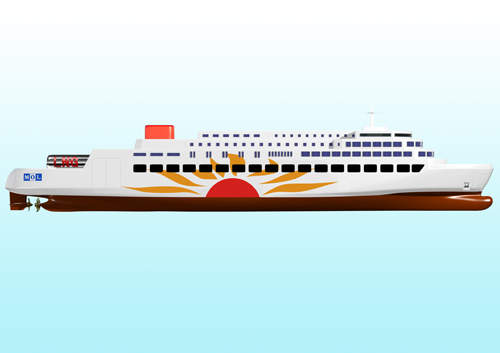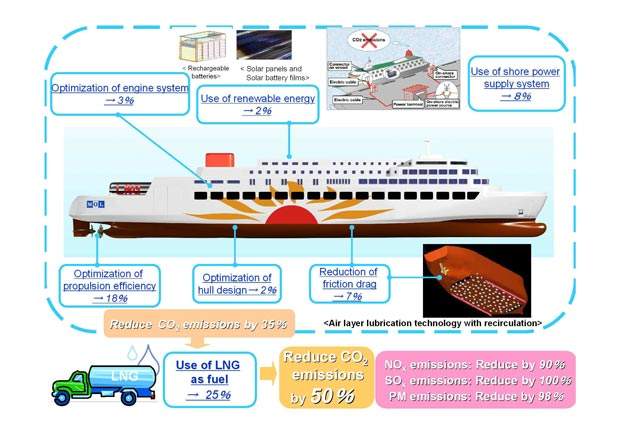The ISHIN-II is an environmentally friendly RoPax ferry concept being developed by Japan-based Mitsui OSK Lines (MOL).
The ISHIN-II will be the second ship in MOL’s next-generation series of vessels. The first vessel in the series, ISHIN-I, an environmentally friendly car carrier, was announced in September 2009.
Following the introduction of the ferries, MOL will achieve significant reductions in CO2 emissions (50%), SOx (98-100%), NOx (90%) and particulate matter (98%) each voyage compared to the company’s existing ferry fleet.
MOL’s ferry service network is spread over Japan, from Hokkaido Island in the north to Kagoshima in the south. The ferry is expected to replace vehicles isuch as trucks and aeroplanes.
Green design
The ferry will have an improved hull form to achieve optimum fuel efficiency. Liquefied natural gas will be used as fuel for the engine and power generation systems.
Electricity will be mainly generated from renewable energy sources. The onshore terminal will provide power when the ship is in port or berthed to cut emissions.
It will also have solar battery film on all cabin windows, which produce solar power for the ferry’s electricity needs. High-capacity rechargeable lithium ion batteries will be installed to store excess energy.
Air layer lubrication technology will be used to reduce friction drag and to collect and recirculate air. The process involves the release of tiny bubbles around the underside of the ship. The bottom of the ferry will be painted with a next-generation, ultra-low friction coating to create a smooth surface that reduces friction drag.
Features
The ISHIN-II will also offer passenger-friendly facilities and passenger-focused services. The boarding process will be simplified with IT-based boarding procedures. The ferry will have facilities to load and offload vehicles. A rampway will also be available for passenger cars.
The propulsion system will generate over 20% less CO2 per thermal unit in comparison to heavy fuel oil-powered conventional ferries. Maximum propulsion efficiency with less noise and vibration will be achieved through the smaller engine.
Propulsion
Equipped with contra-rotating propeller system, the ISHIN-II will have a diesel engine and electric propulsion motor. The propellers will be aligned front to back and fitted with propeller boss cap fins.
The propellers will rotate in opposite directions to distribute the load of propelling the ship. The energy generated from front propeller rotation is absorbed by the rear propeller to increase efficiency. The system has been installed on over 1,700 vessels.
Fuel supply to the engine will be optimised with electronic control. The gas exhausted from the engine will not contain SOx. The gas will be retrieved and reused to produce more thermal energy in comparison to the engines fuelled by heavy fuel oil.









